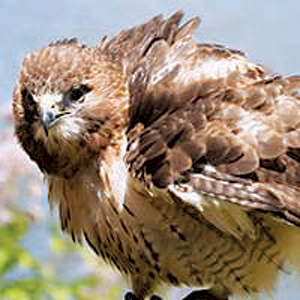RARE BIRD ON A SUNNY MORNING

It was early morning, the sky was clear and the sun was just above the horizon, a bright golden ball in the eastern sky. I’d seen the sun from the bathroom window which is on the opposite side of the house from my study. The hawk was facing east and its breast looked as bright as the sun.
The red-shouldered hawk is a buteo, a hawk with broad wings, like the more common red-tailed hawk. It’s the shape of a red-tailed hawk but smaller, a couple inches shorter. It’s brown on the back and wings like a red-tail, except the upper sides of the bends of its wings which are red spotted with black. It’s also red, a lighter red, on the throat and upper breast, shading into still lighter red, then yellow on its lower abdomen. Its head is yellowish-brown, its tail is banded black and white.
According to Russell E. Mumford and Charles E. Keller in Birds of Indiana, “The red-shouldered hawk once was more abundant than the red-tailed hawk in much of Indiana, but there has been a drastic decrease in its numbers since 1900. This once common bird in Indiana is now a rare to very rare summer and winter resident.
The red-shouldered hawk’s range is southeastern Canada and northeastern U.S. west into Minnesota, south throughout Florida and west into eastern Oklahoma and Texas. That includes the eastern half of Iowa, the state where I was born and grew up. But I lived in northwest Iowa and never saw a red-shouldered hawk there.
Decline in number is one reason red-shouldered hawks are seldom seen. Habitat is another. Red-tailed hawks are birds of open fields, open woodlands and woodland edges. Red-shouldered hawks are birds of mature forests and forest edges. They often perch in a tall tree at the edge of a woods, fly out and down to catch field mice and other little critters they spot on the ground in the adjacent open land, then fly back to the trees. The one I saw a few days ago was perched in a tree at the edge of a woodland. Red-tailed hawks, when hunting, often perch in the open on power poles and power lines.
Red-shouldered and red-tailed hawks both build their nests in trees. Both build platforms of sticks high up in trees. But red-shoulders build in trees in mature forests, red-shoulders in open woodlands. That’s another reason for the decline of red-shouldered hawks, loss of nesting habitat by forest cutting.
Red-shoulders and red-tailed, marsh, rough-legged, Coopers and sharp-shinned, have all been called hen hawks and chicken hawks. Individual hawks do occasionally kill and eat a chicken.
Red-shouldered and red-tailed hawks prey primarily on small rodents, which makes them, according to one account I read, “far more beneficial than harmful, even if they do kill a chicken now and then.”
Red-shouldered hawks kill and eat almost any critter they can catch. In addition to mice and shrews they kill crayfish, fish, earthworms, large insects, snakes and small birds. Which makes me wonder, was the red-shouldered hawk I saw perched in the tree across the road plotting preparing to swoop down on a bird at my bird feeder?
I think not since I haven’t seen it since that morning a few days ago. It was a morning of bright sunshine, rare in itself this year, and a rare bird.
- Birds As Weather Forecasters – Life In The Outdoors - December 17, 2021
- Rare Bird Spotted In Indiana – Life In The Outdoors - October 8, 2021
- MY EXPERIENCE WITH DEER – Life In The Outdoors - July 30, 2021


